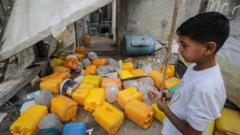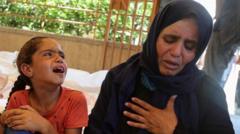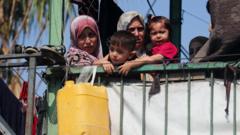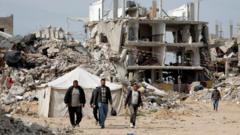As Gaza faces devastation from military actions, experts warn the presence of asbestos in the rubble poses long-term health risks, including mesothelioma and other lung diseases.
Asbestos Dangers Lurk Amid Gaza's War-Torn Rubble
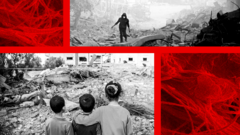
Asbestos Dangers Lurk Amid Gaza's War-Torn Rubble
The ongoing conflict in Gaza presents a hidden threat: asbestos contamination in debris.
Israel's military operations in Gaza have unearthed a deadly risk hidden within the debris: asbestos. This toxic mineral, once prevalent in construction materials, releases harmful fibers into the air, which can lead to severe lung diseases such as mesothelioma. As asbestos use is now banned in many countries, the old structures in Gaza, built prior to the bans, pose significant health threats.
The United Nations Environment Programme (UNEP) estimates that as much as 2.3 million tons of wreckage may contain asbestos, particularly in urban refugee camps established for Palestinians displaced during the 1948-49 war. Experts like Professor Bill Cookson from the UK highlight how the ruined environment of Gaza has become “very, very toxic,” leaving a legacy that may affect future generations despite immediate dangers from ongoing military operations.
The concern extends beyond visible devastation. As airstrikes disturb the rubble, microscopic fibers can become airborne, entering the lungs of those nearby. Chronic exposure can result in asbestosis and mesothelioma, both debilitating illnesses that may take decades to manifest. Professor Cookson warns about the insidious nature of asbestos exposure, noting that even minimal inhalation can have dire consequences.
The situation in Gaza is complicated by its dense population of about 2.1 million people in an area roughly the size of London. Dr. Ryan Hoy, who has studied dust inhalation, points out that avoiding asbestos exposure is nearly impossible given the circumstances. Furthermore, with immediate survival concerns leading the inhabitants' priorities, awareness of asbestos-related risks has dwindled, leaving many vulnerable to potential long-term health consequences.
After conflicts in 2009, assessments revealed asbestos in debris such as roofs and temporary structures, suggesting that this is not a new issue. Despite global recognition of asbestos dangers, its presence remains prevalent, particularly in older buildings in Gaza. The material ranges from less dangerous varieties to highly carcinogenic forms like crocidolite, which have previously been documented in the region.
The WHO warns that diseases caused by asbestos exposure might eclipse casualties from bombs and military operations, projecting a grim future for Gazans. Comparisons have been drawn to the health impacts from the toxic dust clouds following the 9/11 attacks, which have led to thousands of illnesses and deaths among first responders and residents.
International efforts to manage the reconstruction of Gaza post-conflict must tread carefully to prevent further asbestos disturbance. Officials predict that the cleanup operations could span 21 years and cost up to $1.2 billion, revealing the complexity and necessity of addressing this hidden hazard amid the visible chaos of war.
As the situation in Gaza continues to evolve with escalating military operations, the interplay between immediate combat fears and long-term health crises remains a critical discussion point for humanitarian organizations and health experts alike.






